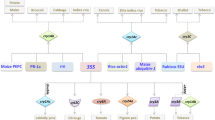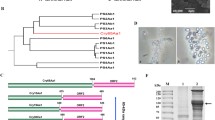Abstract
Cyt1Aa is a major mosquitocidal protein synthesized during sporulation of Bacillus thuringiensis subsp. israelensis, composing more than 50 % of its parasporal body. This high level of synthesis is due to several factors including three strong sporulation-dependent promoters, a strong transcription termination sequence, and an associated 20-kDa helper protein. Cyt1Aa’s toxicity is low compared to the Cry proteins of this species, namely, Cry4Aa, Cry4Ba, and Cry11Aa, but it nevertheless plays an important role in the biology of B. thuringiensis subsp. israelensis in that it synergizes their mosquitocidal toxicity and suppresses the evolution of resistance. In the present study, the effects of using different cyt1Aa promoter combinations and plasmid copy number on synthesis of Cyt1Aa were evaluated. Using the 4Q7 (plasmid-cured) strain of B. thuringiensis subsp. israelensis as an experimental host, a plasmid copy number of two or three yielded no Cyt1Aa, whereas a copy number of four yielded only small crystals, even when expression was driven by one of the wild-type promoters. However, using all three wild-type promoters and a plasmid copy number of 20 yielded Cyt1A crystals tenfold larger than those produced by one promoter and a plasmid copy number of four. High levels of Cyt1Aa synthesis resulted in significantly fewer spores per unit medium and imperfectly formed crystals. Similar results were obtained when Cyt1Aa synthesis was evaluated using the same expression constructs in a mutant strain of B. thuringiensis subsp. israelensis that lacks the cyt1Aa gene.




Similar content being viewed by others
References
Arantes O, Lereclus D (1990) Construction of cloning vectors for Bacillus thuringiensis. Gene 108:115–119
Barbosa-Corona JE, Park H-W, Bideshi DK, Federici BA (2012) The 60-kilodalton protein encoded by orf2 in the cry19A operon of Bacillus thuringiensis subsp. jegathesan functions like a C-terminal crystallization domain. Appl Environ Microbiol 78:2005–2012
Bernhard K, Schrempf Goebel W (1978) Bacteriocin and Antibiotic resistance plasmids in Bacillus cereus and Bacillus subtilis. J Bacteriol 133:897–903
Berry C, O’Neil S, Ben-Dov E, Jones AF, Murphy L, Quail MA, Holden MT, Harris D, Zaritsky A, Parkhill J (2002) Complete sequence and organization of pBtoxis, the toxin-coding plasmid of Bacillus thuringiensis subsp. israelensis. Appl Environ Microbiol 68:5082–5095
Bourgouin C, Delécluse A, de la Torre F, Szulmajster J (1990) Transfer of the toxin protein genes of Bacillus sphaericus into Bacillus thuringiensis subsp. israelensis and their expression. Appl Environ Microbiol 56:340–344
Chaoyin Y, Wei S, Sun M, Lin L, Faju C, Zhengquan H, Ziniu Y (2007) Comparative study on effect of different promoters on expression of cry1Ac in Bacillus thuringiensis chromosome. J Appl Microbiol 103:454–461
Federici BA, Bauer LS (1998) Cyt1Aa protein of Bacillus thuringiensis is toxic to the cottonwood leaf beetle, Chrysomela scripta, and suppresses high levels of resistance to Cry3Aa. Appl Environ Microbiol 64:4368–4371
Federici BA, Park H-W, Bideshi DK (2010) Overview of the Basic biology of Bacillus thuringiensis with emphasis on genetic engineering of bacterial larvicides for mosquito control. In: Zaritsky A, Ben-Dov E (eds) Entomopathogenic bacterial toxins as biological control agents, Supplementary Issue, Open Toxicology Journal, vol 3. Kluwer Academic Publishers, Dordrecht, pp 154–171
Federici BA, Park H-W, Sakano Y (2006) Insecticidal protein crystals of Bacillus thuringiensis. In: Shively JM (ed) Microbiology Monographs, vol 1., Inclusions in ProkaryotesSpringer, Heidelberg, pp 195–236
Ibarra JE, Federici BA (1986) Isolation of a relatively non-toxic 65-kilodalton protein inclusion from the parasporal body of Bacillus thuringiensis subsp. israelensis. J Bacteriol 165:527–533
Laemmli UK (1970) Cleavage of structural proteins during the assembly of the head bacteriophage T4. Nature 227:680–685
Lereclus D, Arantes O, Chaufaux J, Lecadet M-M (1989) Transformation and expression of a cloned δ-endotoxin gene in Bacillus thuringiensis. FEMS Microbiol Lett 60:211–218
Mesrati LA, Karray MD, Tounsi S, Jaoua S (2005) Construction of a new high-copy number shuttle vector of Bacillus thuringiensis. Lett Appl Microbiol 41:361–366
Park H-W, Bideshi DK, Federici BA (2000) Molecular genetic manipulation of truncated Cry1C protein synthesis in Bacillus thuringiensis to improve stability and yield. Appl Environ Microbiol 66:4449–4455
Park H-W, Bideshi DK, Federici BA (2003) Recombinant strain of Bacillus thuringiensis producing Cyt1A, Cry11B, and Bacillus sphaericus binary toxin. Appl Environ Microbiol 69:1331–1334
Park H-W, Bideshi DK, Johnson JJ, Federici BA (1999) Differential enhancement of Cry2A versus Cry11A yields in Bacillus thuringiensis by use of the cry3A STAB mRNA sequence. FEMS Microbiol Lett 181:319–327
Park H-W, Bideshi DK, Wirth MC, Johnson JJ, Walton WE, Federici BA (2005) Recombinant larvicidal bacteria with markedly improved efficacy against Culex vectors of West Nile Virus. Am J Trop Med Hyg 72:732–738
Park H-W, Delécluse A, Federici BA (2001) Construction and characterization of a recombinant Bacillus thuringiensis subsp. israelensis strain that produces Cry11B. J Invertebr Pathol 78:37–44
Park H-W, Ge B, Bauer LS, Federici BA (1998) Optimization of Cry3A yields in Bacillus thuringiensis by use of sporulation-dependent promoters in combination with the STAB-SD mRNA sequence. Appl Environ Microbiol 64:3932–3938
Park H-W, Pino BC, Kozervanich-Chong S, Hafkenscheid EA, Oliverio RM, Federici BA, Bideshi DK (2013) Cyt1Aa from Bacillus thuringiensis subsp. israelensis enhances mosquitocidal activity of B. thuringiensis subsp. kurstaki HD-1 against Aedes aegypti but not Culex quinquefasciatus. J Microbiol Biotechnol 23:88–91
Park H-W, Tang M, Sakano Y, Federici BA (2009) A 1.1-kilobase region downstream of the bin operon in Bacillus sphaericus strain 2362 decreases Bin yield and crystal size in strain 2297. Appl Environ Microbiol 75:878–881
Pérez-García G, Basurto-Ríos R, Ibarra JE (2010) Potential effect of a putative σH-driven promoter on the over expression of the Cry1Ac toxin of Bacillus thuringiensis. J Invertebr Pathol 104:140–146
Sun Y, Zhao Q, Xia L, Ding X, Hu Q, Federici BA, Park H-W (2013) Identification and characterization of three previously undescribed crystal proteins from Bacillus thuringiensis subsp. jegathesan. Appl Environ Microbiol 79:3364–3370
Tang M, Bideshi DK, Park H-W, Federici BA (2006) A mini-replicon from pBtoxis of Bacillus thuringiensis subsp. israelensis. Appl Environ Microbiol 72:6948–6954
Wirth MC, Delécluse A, Federici BA, Walton WE (1998) Variable cross-resistance to Cry11B from Bacillus thuringiensis subsp. jegathesan in Culex quinquefasciatus (Diptera:Culicidae) resistant to single or multiple toxins of Bacillus thuringiensis subsp. israelensis. Appl Environ Microbiol 64:4174–4179
Wirth MC, Federici BA, Walton WE (2000) Cyt1A from Bacillus thuringiensis synergizes activity of Bacillus sphaericus against Aedes aegypti (Diptera:Culicidae). Appl Environ Microbiol 66:1093–1097
Wirth MC, Park H-W, Walton WE, Federici BA (2005) Cyt1A of Bacillus thuringiensis delays evolution of resistance to Cry11A in the mosquito Culex quinquefasciatus. Appl Environ Microbiol 71:185–189
Wu D, Federici BA (1993) A 20-kilodalton protein preserves cell viability and promotes CytA crystal formation during sporulation in Bacillus thuringiensis. J Bacteriol 175:5276–5280
Wu D, Johnson JJ, Federici BA (1994) Synergism of mosquitocidal toxicity between CytA and CryIVD proteins using inclusions produced from cloned genes of Bacillus thuringiensis. Mol Microbiol 13:965–972
Acknowledgments
This research was supported by a grant from the National Institutes of Health (1 RO1 AI45817).
Author information
Authors and Affiliations
Corresponding author
Ethics declarations
Conflicts of Interests
None of the authors of this study has a conflict of interest.
Rights and permissions
About this article
Cite this article
Park, HW., Hice, R.H. & Federici, B.A. Effect of Promoters and Plasmid Copy Number on Cyt1A Synthesis and Crystal Assembly in Bacillus thuringiensis . Curr Microbiol 72, 33–40 (2016). https://doi.org/10.1007/s00284-015-0911-x
Received:
Accepted:
Published:
Issue Date:
DOI: https://doi.org/10.1007/s00284-015-0911-x




